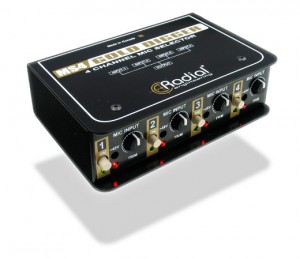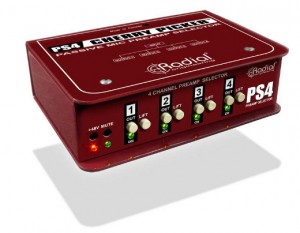Radial Debuts Gold Digger Passive Mic Selector, and Cherry Picker Preamp Selector
Two new tools have appeared to streamline the selection process for mics and preamps, during fast-moving studio sessions.
Both of them come from Radial Engineering, starting with the Gold Digger, debuting this month with an MSRP of $400. Uniquely, the Gold Digger enables studio engineers to quickly compare and select the best-sounding microphone to suit the character of a particular voice.
Here’s how Radial describes the Gold Digger:
“Radial President Peter Janis explains: ‘Capturing the essence of a voice is critical during the recording process. This is best accomplished by selecting the most appropriate microphone and suitable mic preamp. But setting up an ‘honest’ comparison between microphones can be difficult due to the time lapse involved when routing signals and discrepancies between mixer channels.
‘The Gold Digger solves the problem by routing four microphones to a single output via a “straight wire” signal path. In other words, there are no buffers or any form of gain stage in between the microphone and the output, thus assuring a color-free signal transfer without distortion or artifact.’
The Gold Digger features four ‘radio style’ switches to ensure only one microphone will be activated at any one time. 48V phantom power is generated and managed inside the unit to ensure switching between mics will be quiet and pop free. One simply plugs in the microphones, activates phantom power for condensers and then sets the trim control so that all mics produce the same output level. One simply activates the ‘live’ mic by selecting the desired channel. Quiet, dependable and ‘immediate’, the Gold Digger makes selecting the best mic for a given application easy and improves workflow at the same time.”
Next up from Radial Engineering is the Cherry Picker (MSRP: $400), designed to allow studio engineers to connect a microphone, and select between four mic preamps in order to optimize the signal path and deliver the best sonic performance.
The full information from the company reads thusly:
“Compact and exceedingly easy to use, the Cherry Picker is a ‘straight wire’ passive switcher that features a balanced mic input with four outputs. Front panel ‘radio-style’ selector switches enable the engineer to select the active preamp while the Cherry Picker automatically shuts off the others. Audio signal switching is actually performed using military-grade gold contact sealed relays. This ensures the signal will be transferred from input to output without introducing distortion, coloration or artifact of any kind.
Radial President, Peter Janis explains: ‘We noticed that many studios offer a variety of microphones and preamps to their clients. But switching between them to audition is often cumbersome as it usually requires muting the microphone, connecting cables at the patchbay and then readjusting the levels. The time delay between tests makes it practically impossible to remember one sonic signature versus another. The Cherry Picker lets you instantly audition and compare several mic preamps improving work flow efficiency. Engaging the artist during the preamp selection process increases the comfort level of the artist and this usually results in a better musical performance, improving the sound of the track.’
To ensure quiet switching when using studio condensers, the Cherry Picker generates its own 48 volt phantom power for a stable supply to the microphone. This eliminates turning on and off the phantom power on each preamp. Each output is equipped with a ground lift switch to help eliminate buzz and hum caused by ground loops. A conveniently located front panel mute switch allows the Cherry Picker to be put on hold while the microphone is exchanged without having to readjust signal levels or mute preamps.”
Please note: When you buy products through links on this page, we may earn an affiliate commission.









Deane Patterson
November 19, 2012 at 2:54 am (12 years ago)Sounds like a winner (in both cases) even for smaller studios where the futzing around auditioning mics often leads to just using what’s already set up. I don’t know if there is a market for combing both units into a sort of ‘matrix’ or poor man’s prewired patchbay, but that would be uber useful.